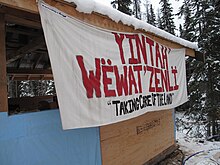2020 Canadian pipeline and railway protests
From January to March 2020, a series of civil disobedience protests were held in Canada over the construction of the Coastal GasLink Pipeline (CGL) through 190 kilometres (120 mi) of Wetʼsuwetʼen First Nation territory in British Columbia (BC), land that is unceded.
In January 2019, the Royal Canadian Mounted Police (RCMP) of British Columbia removed the blockades and CGL pre-construction work in the territory was completed.
In December 2020, the provincial Environmental Assessment Office found that CGL had failed to properly comply with erosion and sediment control measures,[7] a violation which posed a major risk to the health of the waterways the pipeline moves through.
The violations cited by the EAO have affected numerous waterways during construction, including 68 wetlands, and even disrupting Fraser Lake with turbid water.
[19] In 1997, the Supreme Court of Canada issued the Delgamuukw-Gisdayʼwa decision, which ruled that aboriginal title exists as an exclusive territorial right for indigenous people.
[20] The rights and title issue has also been the basis for several solidarity protests, which have also objected to the actions and presence of the RCMP within the Wetʼsuwetʼen traditional territory (known in Babine-Witsuwitʼen as yintah).
[22] After TC Energy received its partners' go-ahead in November, it appealed to the Supreme Court of British Columbia to grant an injunction to stop the blockade of its intended route through the Wetʼsuwetʼen territory.
[23] On January 7, the RCMP conducted a raid to enforce TC Energy's injunction, removing the barricades on the Morice Forest Service Road and arresting 14 of the Wetʼsuwetʼen land defenders.
"[36] During the enforcement action by the RCMP, a large amount of advanced equipment was used, including heavily armed tactical teams, division liaison personnel, regular uniformed officers, canine units, helicopters, drones and snowmobiles, according to CBC News.
[39] After the hereditary chiefs made it a condition for talks with government, the RCMP closed their local office and moved to their detachment in Houston on February 22.
It also establishes a twelve-month timeline for negotiation on jurisdiction including over land-use planning, resources, water, wildlife, fish, and child and family wellness.
The Office of the Wet’suwet’en requested that the Court reject the province's decision to extend CGL's environmental certificate for five years.
[12] Sleydoʼ (Molly Wickham), one of the leaders of Gidimtʼen Access Point, claimed that the work near the river would disrupt her people's livelihoods as well as the salmon population.
A Gidimtʼen Access Point press release called the Morice River "sacred headwaters that nourish the Wetʼsuwetʼen Yintah [territory] and all those within its catchment area".
Coastal GasLink president Tracy Robinson issued a statement about the drilling, saying "our crews will utilize a micro-tunnel method which is a type of trenchless crossing that is constructed well below the riverbed and does not disturb the stream or the bed and banks of the river".
[113] On February 19, activists set up a blockade on the Mont-Saint-Hilaire rail line in Saint-Lambert, Quebec, promising to stay until the RCMP leaves the disputed zone in Wetʼsuwetʼen territory.
[120] The blockades led to the shutdown of CNR's Eastern Canadian network, causing a complete halt of freight traffic from Halifax west to Toronto.
"[122] Due to a poor growing season which resulted in an unusually late harvest just before Christmas, Canadian wheat and barley shipments were already in a backlog and were further impacted by the rail blockades.
[123] Canadian Federation of Agriculture president Mary Robinson warned of "huge financial consequences" as farmers do not get paid until products are delivered to the market.
[125] Supply chains for chlorine, jet fuel and de-icing fluid all rely on rail transport: "You can't put it in a truck and send it down the 401" said an executive of the Chemistry Industry Association of Canada.
[127] The disruption of propane rail shipments was expected to lead to shortages and rationing,[128] during a time when many communities were experiencing extremely cold weather.
On February 15, Miller met the Mohawks in a ceremonial encounter on the CNR train tracks to renew a 17th-century treaty between the Iroquois and the British Crown known as the Silver Covenant Chain.
[137] Miller asked for a temporary drawback of the protest but his request was refused after Wetʼsuwetʼen hereditary Chief Woos, who was on the phone, stated that the RCMP was still on his territory and "they are out there with guns, threatening us."
Opposition leader Andrew Scheer condemned the government's refusal to use the police to stop the illegal blockades, calling it "the weakest response to a national crisis in Canadian history.
"[141] On February 20, according to a statement from Canadian Public Safety Minister Bill Blair, the RCMP agreed to move its personnel from Wetʼsuwetʼen territory to nearby Houston.
[144] On February 24, the day of the Mohawk blockade removal by the OPP, Indigenous Services Minister Miller repeated that the Liberal government was "still open for dialogue" and willing to negotiate.
[145] On February 24, in a statement signed and supported by over 200 Canadian lawyers and legal scholars, Beverly Jacobs and Sylvia McAdam of the University of Windsor, Alex Neve of Amnesty International, and Harsha Walia of the BC Civil Liberties Association responded to the calls for the "rule of law."
[147] They repeated this demand in a statement on May 14, after the signing of the MOU, and added a call for Minister Marc Miller to speak up about his "intention to protect the programs and services the Wetʼsuwetʼen people depend on".
[149] Documents obtained by CBC News in 2019 found that in the two years of their near constant presence on the Morice Forest Service Road, the RCMP had spent over CA$13 million on policing.
Chief Naʼmoks compared that very high level of spending with the perceived inaction by the RCMP over violent attacks and harassment of Mi'kmaw fishers in Nova Scotia.



